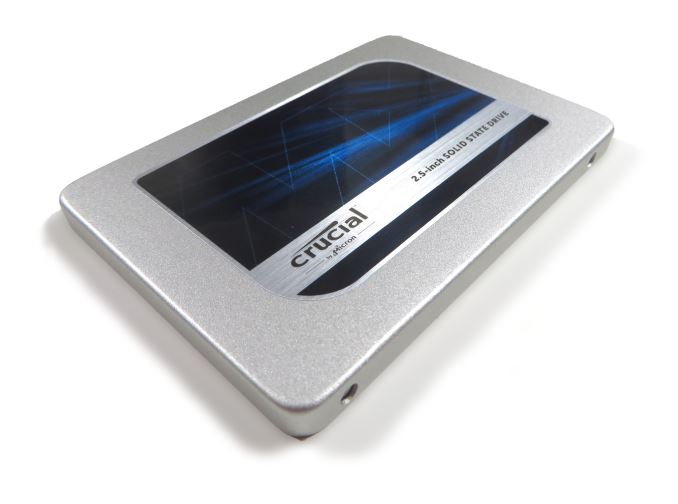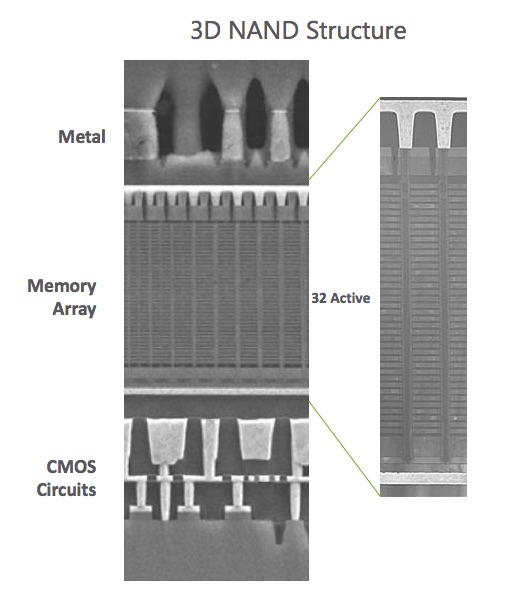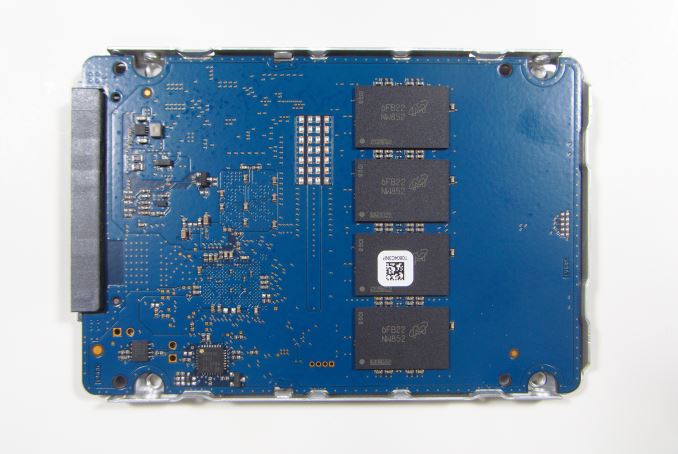The Crucial MX300 750GB SSD Review: Micron's 3D NAND Arrives
by Billy Tallis on June 14, 2016 9:00 AM EST
Micron is the second company to the 3D NAND flash milestone, with today's release of the Crucial MX300 750GB Limited Edition. This follows on from two years ago when Samsung became the first manufacturer to ship SSDs with 3D NAND flash, the 850 Pro - a drive launched as a flagship high end drive and remains the fastest consumer SATA drive today. By contrast, the Crucial MX300 is intended to be a mainstream affordable SSD based on 3D TLC NAND, making the MX300 more of a direct competitor to the 850 Evo.
Micron's strategy for transitioning to 3D NAND is quite different from the path that Samsung took. Similar to other projects, Micron is once more partnered with Intel to produce this generation of flash memory, and their 3D NAND is different compared to Samsung in several ways. While the rest of the industry chose to combine the 3D NAND transition with a switch from a floating gate memory cell to a charge trap design, Intel and Micron's 3D NAND is still a floating gate design, making the end-point a 'simpler' two-step process. As a result, the capacity is also quite different: Samsung's 3D NAND debuted with a 32-layer but small 86Gb MLC die and 128Gb TLC, later followed up with a 128Gb MLC, whereas the Intel/Micron first effort on 32-layer 3D NAND is an MLC part with a capacity of 256Gb and a TLC part with 384Gb, making for a much larger die. While Samsung has continued to develop planar NAND alongside their 3D NAND and recently reintroduced planar NAND to their retail SSD family with the 750 EVO, Micron is committed to going all-3D with new products. To be clear however, Micron's existing planar NAND products won't be going away quickly (especially in the enterprise market).
The Crucial MX300 750GB
The MX300 was first made official at a Micron enterprise storage event with a release planned for April/early Q2. While the launch of the full range of drives was pushed back to allow for a new firmware revision with improved performance to go through a QA cycle, Micron is sticking with the original plan of first launching a limited edition single 750GB capacity, with the full range of capacities and M.2 versions to fill in over the rest of the year. With seven extra weeks of firmware work behind them, supplies of the 750GB MX300 may not be as limited as they would have been for an April launch, but availability could be temporarily constrained as the drives with the updated firmware make their way through the supply chain. Despite this, we also expect that a tight supply of the 3D TLC was a contributing factor in a staggered release, and as a result we start with the Limited Edition first.
750GB is not a typical capacity for a SSD, but the 384Gb (48GB) die capacity of Micron's 3D TLC makes it hard to hit the usual power of two drive capacity points without having a much larger overprovisioning ratio than is typical of a consumer drive. Instead, the MX300 line will probably be the first time we see TLC clearly resulting in an increase of capacity relative to MLC drives across the full range of products, rather than just offering a lower price per GB (and one extra capacity at the high end). Micron hasn't nailed down the final specifications for the other capacities of MX300, but we do know that the smallest drive will use six dies. This will give it a raw capacity of 288GB and the usable capacity may be around 275GB rather than something in the 240-256GB range. The largest (and last to launch) capacity will be in the neighborhood of 2TB. The 750GB model uses sixteen dies arranged in eight packages of two dies each for a raw capacity of 768GB.
In the past, when NAND transitions to a smaller lithography node and a larger die capacity, the reduction in die count has caused a decrease in available parallelism and thus lower performance for drives of the same capacity. Micron is offsetting this by partitioning their 3D NAND into a four plane design, where 128Gb planar flash chips are at most two plane designs. This allows for almost as many commands to be processed simultaneously by the 3D TLC, but will also lead to somewhat higher contention on the link between the controller and the flash.
| Crucial MX Series Specifications | ||||
| Capacity | MX300 750GB | MX200 500GB | MX200 1TB | |
| Form Factors | 2.5" | 2.5", mSATA, M.2 | 2.5" | |
| Controller | Marvell 88SS1074 | Marvell 88SS9189 | ||
| NAND | Micron 384Gbit 32-layer 3D TLC |
Micron 16nm 128Gbit MLC |
||
| DRAM | 512MB | 512MB | 1GB | |
| Sequential Read | 530MB/s | 555MB/s | 555MB/s | |
| Sequential Write | 510MB/s | 500MB/s | 500MB/s | |
| 4KB Random Read | 92K IOPS | 100K IOPS | 100K IOPS | |
| 4KB Random Write | 83K IOPS | 87K IOPS | 87K IOPS | |
| Dynamic Write Acceleration | Yes | Yes (mSATA and M.2 models only) | No | |
| DevSleep Power | 4mW | 2mW | 2mW | |
| Slumber Power | 75mW | 100mW | 100mW | |
| Max Power | 5.2W | 4.7W | 5.2W | |
| Encryption | TCG Opal 2.0 & IEEE-1667 (eDrive) | |||
| Endurance | 220TB | 160TB | 320TB | |
| Warranty | Three years | |||
| Price | $199.99 (MSRP) | $139.00 | $269.94 | |
Aside from adopting 3D TLC and upgrading to the latest in Marvell's long line of SATA SSD controllers, the MX300 offers all the usual features of the MX series: encryption support, SLC caching, partial power loss protection and a three year warranty. Performance and endurance specifications are down slightly from the MX200 due to the new hardware, but are still fine for a mainstream SATA SSD. The final decisions about overprovisioning for the other capacity models could mean they will have better endurance ratings than the MX200 of comparable capacity.
From the exterior the MX300 appears virtually identical to a MX200. Opening it up to look at the PCB, we see a full size circuit board with plenty of room for more NAND, but Micron won't actually need more than the 8 packages in this drive for even the largest 2TB class model. This 750GB drive stacks just two dies per package; a 2TB class drive would need at most six dies per package, but stacking 8 or 16 dies per package is common when dealing with smaller NAND chips and especially smaller form factors. The pads for the power loss protection capacitors are almost all populated.
The 750GB Crucial MX300 comes with a MSRP of $199.99. On a price per GB basis, this puts it on par with the current actual retail prices for the MX200 and we expect competition can drive the MX300 price down further. It will probably take up position near the top of the budget planar TLC segment of the market and be cheaper than all but the best sale prices on MLC drives. So while at first glance the MX300 might appear to be the natural match against the 850 EVO, Micron is clearly aiming lower in price.
In addition to the Crucial MX200 and 3D TLC based 850 EVO, the MX300 will compete against the top performing planar TLC drives like the SanDisk X400, which is based on the same Marvell 88SS1074 controller used in the MX300.
| AnandTech 2015 SSD Test System | |
| CPU | Intel Core i7-4770K running at 3.5GHz (Turbo & EIST enabled, C-states disabled) |
| Motherboard | ASUS Z97 Pro (BIOS 2701) |
| Chipset | Intel Z97 |
| Memory | Corsair Vengeance DDR3-1866 2x8GB (9-10-9-27 2T) |
| Graphics | Intel HD Graphics 4600 |
| Desktop Resolution | 1920 x 1200 |
| OS | Windows 8.1 x64 |
- Thanks to Intel for the Core i7-4770K CPU
- Thanks to ASUS for the Z97 Deluxe motherboard
- Thanks to Corsair for the Vengeance 16GB DDR3-1866 DRAM kit, RM750 power supply, Carbide 200R case, and Hydro H60 CPU cooler













85 Comments
View All Comments
hechacker1 - Tuesday, June 14, 2016 - link
Is the driver not included with Windows 10 yet?Billy Tallis - Tuesday, June 14, 2016 - link
Windows 8.1 includes basic NVMe support and will boot from a NVMe drive with no trouble. Windows 10 added support for some of the more obscure features like the administrative commands necessary for secure erase. But the driver loading that has the most potential to affect boot performance is the UEFI NVMe driver, which some motherboards might not load until after probing for the existence of any NVMe devices that they would need to inspect for the presence of a bootloader.Impulses - Tuesday, June 14, 2016 - link
Don't see how that's possible unless your needs are pretty basic and sufficiently sated by a single drive, maybe two, in which case you probably don't need the performance of a PCI-E drive...Running a smaller 256GB SM951 here and two SATA 1TB 850 EVO, the only thing I see changing in that equation is going to 512GB for the OS apps drive and to multiple 2TB drives on the SATA side.
Whether PCI-E drives should cost more than SATA ones or not isn't the issue, they're gonna keep carrying a premium as long as they're only really useful to a small niche... The only thing that will potentially lower prices quickly is their common use on laptops, but they can also opt for lower end SATA M.2 drives.
Lolimaster - Saturday, June 18, 2016 - link
The main things most of the users notices changing and HDD for an SSD is the orders of magnitude lower latency/access time and 4k/4k random performance.That's why unless you have an specific need for faster transfer rates people wont notices differences between pcie/sata ssd,
smilingcrow - Tuesday, June 14, 2016 - link
“The lack of significant competition in the PCIE3.0 X4 NAND drives bringing down prices quickly is disconcerting.Buying into SATAIII SSDs at this point in time simply is a bad idea comparatively.”
But on the other hand buying into PCIe drives at this point when the pricing is so high when for many users the benefits over SATA drives is minimal for general usage makes them a bad idea relatively.
azazel1024 - Wednesday, June 15, 2016 - link
Or, you know, for all of the folks who don't have a chipset or board that supports m.2, let alone m.2 PCI-e drives currently. I am still rolling an Ivy Bridge. No m.2 anywhere in my system, and frankly the extra cost to go with an M.2 to PCI-e bridge card, to then pay a premium on an m.2 PCI-e based drive to then drop in...and not confident my board can actually boot from PCI-e storage...Yeah, SATA for me. Frankly drives are cheap enough it isn't that big a deal if I end up dropping $70-80 on an MLC 240GB drive that I use for a couple of years before shuffling it off in to my server as it's boot drive and get an m.2 PCI-e ~480GB drive or similar when finally upgrading my computer to Kaby/Castle.
One benchmark that I wish Anand would do that I have seen a few other sites do are some of the PRACTICAL benchmarks. Such as application load times, or other disk intensive operations to compare between drives, especially between "empty" and "full" states.
Do many users care if Photoshop launches in 5.2s versus 6s of a slower drive? Possibly not, but there probably are some who do. What about reloading 50 web browser tabs? Or loading 100 RAW images from disk in photoshop? A handful of real world tests would be nice to provide some more perspective too. The few sights that do, do that kind of stuff, MLC drives generally seem to have a pretty commanding lead over MLC. Again, many users might not care about shaving a second or two off an application launch time, but some do.
Impulses - Wednesday, June 15, 2016 - link
I went with an M.2 boot drive after seeing the difference it makes in some demanding Adobe tasks on HardOCP's reviews (of the 750 IIRC), but I chose an SM951 with confidence based largely on AT's exhaustive reviews... So yeah I'd agree, some practical tests beyond the patented AT torture tests would be nice, specially at this juncture where some people are still asking whether PCI-E/M.2 is for them... At the end of the day tho, the old cliche probably serves most well, if you even gotta ask then you're probably fine with a SATA drive.Billy Tallis - Thursday, June 16, 2016 - link
Our AnandTech Storage Bench Light, Heavy and Destroyer tests are the tests you're looking for. They're composed entirely of real-world I/O from things like Photoshop, web browsing, gaming, virus scanning, software development and virtual machine use. It wouldn't be useful for us to report dozens of subscores breaking out each individual application: that's an overwhelming amount of data to present and contextualize, short tests of individual applications are harder to make repeatable and valid with high enough resolution, and if you have a single specific use that is most important to you, our synthetic benchmarks probably cover that. Instead we present and analyze three different real-world mixes of I/O.Impulses - Friday, June 17, 2016 - link
It's just hard to translate the results from the Storage Bench to real world impact Billy... Sometimes people just like knowing "oh, it'll actually cut that workload in half". Some may be able to extrapolate that from the AT Bench but it's not immediately obvious. I don't think anyone's asking for a breakdown of every single app involved in the traces, maybe one or two of the most stressful tho? Just a thought.Lolimaster - Saturday, June 18, 2016 - link
They're not.Unless you move tons of data per day with more than 1 pci-e nvme drive there's no difference between sata and pcie ssd's. PCie ssd uses more power and produces more heat.